All anglers face the same dilemma when going on a fishing trip: Should I buy bait, catch bait, or use lures?
Well, if you are anything like me the answer is probably all of the above.
In this article, I want to talk about 5 different ways to find and catch your own worms for fishing bait.
Worms are a fantastic bait source, and although they are usually cheap from bait and tackle shops, catching them yourself is rewarding and can save you money!
Table of Contents
Where to Look to Find Worms
The most common types of worms used in fishing can often be found in household gardens, forest floors, pastures, and other moist vegetated areas.
Let’s take a closer look at where to find the most common types of fishing worms:
Where to Find Nightcrawlers
Nightcrawlers are larger worms that can grow up to 8 inches in length. They prefer cooler temperatures, so they are most often found at deeper depths.
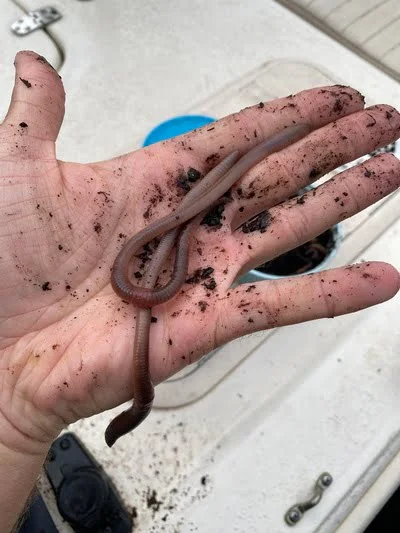
They have been known to burrow down as much as 7 feet, but are most often found at 2 to 3 feet deep.
Nightcrawlers love decaying plant material and manure.
Your best bet to find them is to dig around in garden soil, lawns, or thick forest floors. If the soil that you are digging in is too dry and you are not finding any nightcrawlers, try moving on to the next area.
A live nightcrawler is what Thomas Farchione used to catch the world record Redear Sunfish!
Where to Find Earthworms
The common earthworm is the easiest type of worm to find. These worms are most often found in damp soil and mud near bodies of water (near ditches, ponds, canals or soggy ground)
Other good areas to search are underneath objects that are damp or moist like rocks, logs, and rotten debris.
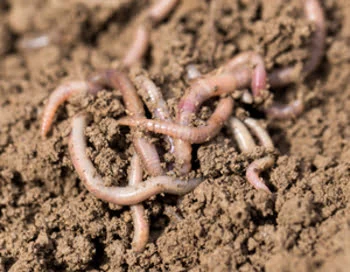
They need moist environments in order to survive, so searching near streams, ponds, and springs is your best bet.
Earthworms grow around 4 to around 6 inches in length, so they are larger than red wigglers but smaller than nightcrawlers. They are usually found near the surface of the soil down to a foot deep.
Where to Find Red Wigglers
Red wigglers, also known as “manure worms”, are some of the easiest worms to find, and popular panfish like bluegill love to eat them!
Anywhere there is a regular supply of manure is sure to have these worms nearby!

If you prefer to avoid digging through manure, they can also be found in and around decaying plant material such as fallen logs and weed piles.
Red wigglers will most often stay very close to the surface, sometimes even on top of the ground. You do not need to dig very deep to find them.
In addition to piles of manure and rotting plant material, red wigglers can sometimes be found in and around lawns and gardens that are watered regularly.
Here you may find them mixed in with other types of worms like nightcrawlers and the common earthworm.
How to Catch Worms
Once you know where to start looking, you are ready to start catching worms! There are a few different techniques that you can use to maximize your time and ensure that you catch the most amount of worms possible.
Catching Worms with Cardboard
One of the easiest methods for catching any type of worm is to find an old cardboard box that you don’t need anymore.
Cut the box so that it can lay flat on the ground, and then soak the box with water from the hose or the sink.
Lay the damp cardboard box on the ground in your lawn or garden overnight (be sure to lay it completely flat). In the morning, carefully lift it up and look underneath. You should find plenty of worms that were attracted to it through the night!
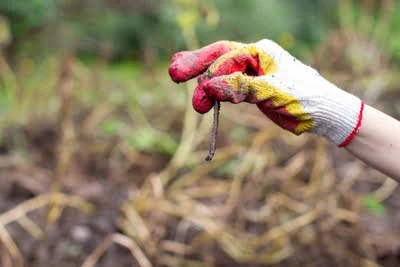
But why are worms attracted to wet cardboard? Most cardboard is made from trees and is very high in cellulose.
This provides an excellent food source for the worms, who will seek it out during the night as they are feeding.
You can’t, however, just use any type of cardboard. Avoid cardboard that is:
- Bleached white
- Shiny
- Has colored ink
- Highly processed
Cardboard with these qualities can contain toxins and plastics that are harmful to worms.
Instead use regular, brown cardboard without any harmful qualities to attract the most amount of worms possible.
Grunting for Worms
Yep, you read that right. You can actually ‘grunt‘ worms right out of the ground. But the grunting noise is actually a vibration sent deep under the soil by rubbing a rasp or metal object against a stake.
The deep and melodic vibrations travel down through the stake, into the surrounding soil…and the worms don’t like it.
All of the rapid vibrations will attract worms that then come out of the ground, making them very easy to catch.
Nobody is really sure why the vibrations cause the worms to come out of the ground, but it is speculated that they think that it is raining. No matter the reason, worm grunting is easy to do and you only need a few basic tools.
A few popular methods for worm grunting include:
- Rubbing a handsaw against a wooden stake in the ground.
- Rubbing a piece of flat metal against a wooden stake in the ground.
- Running a chainsaw while it is resting on top of a wooden stake in the ground.
Your wooden stake should be around a foot in length and an inch in diameter for the best results.
If you can’t find a stake, you can also use a stick that is similar in size. Metal stakes can also be used, although they do require more effort to create the same levels of vibration as any wooden options.
Catching Worms During Rain
During a heavy rainstorm, worms will work their way out of the ground and to the surface.
They do this due to water flooding the tunnels they call home. Since worms need air to breathe, they can suffocate if they do not come up to the surface.
Worms can still survive out of the ground, and most species will need some type of moisture.
Related: Fishing After Rain- Is It Worth It Or A Waste Of Time?
The falling rain and various puddles provide them a great place to wait until the water resides, although they are at a higher risk of being eaten by a predator or picked up by an angler.
As worms come up to the surface during and after a rainstorm, you can walk around and easily collect them for your next fishing trip.
Digging for Worms
The most basic and reliable method of catching worms is to dig through the ground and look for them yourself. All you will need is a regular shovel or hand shovel (depending on how deep you want to look).
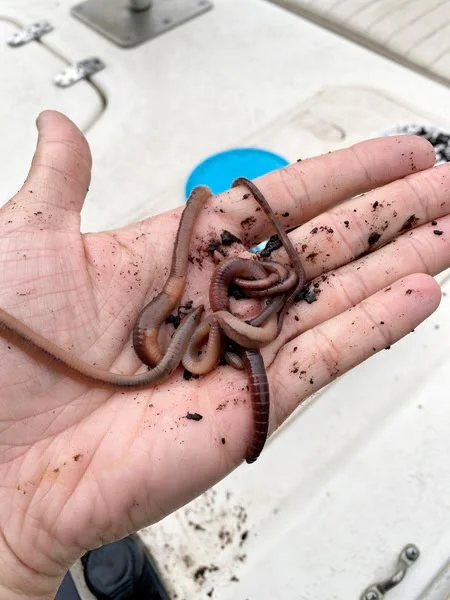
Start your search in areas that worms would like. Fallen leaves, decaying plant matter, and manure are all areas that worms love to inhabit. You also want to avoid digging through your own lawn, even if there are worms underneath it!
Remember that worms can sense vibrations in the ground, so take care not to stomp around in the spot that you intend to dig. This could scare away the worms before you ever get a chance to find them.
If the ground is not moist or you do not find any worms in the hole that you dig, fill the hole back in and move on to another area. With a little bit of trial and error, you will eventually find where the worms are hiding.
Where Do You Put Worms After You Catch Them?
While searching for worms, you will need to prepare a container with holes in the lid in order to keep them in. You can also use a bucket or any other container that is open and provides airflow.
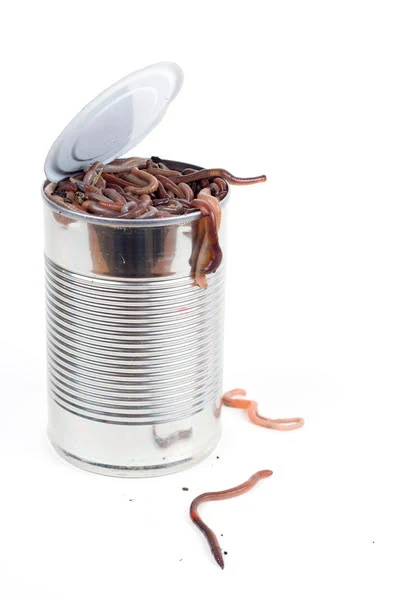
Place an inch or two of regular soil at the bottom of the container. As you catch worms, carefully place them on top of the soil and the worms will bury themselves if they choose to.
If you intend to fish with the worms that you catch, this container will suffice and you don’t need a permanent home. If you want to keep them for a longer period of time or create your own supply of worms, you will need a more suitable home.
How to Store Worms Long Term
If you intend to go fishing within 24 hours of catching worms, you do not need to give your worms any special care or attention. The container that you used to catch them will suffice until it’s time to go fishing.
If you want to store your worms for the long term, you will need to make some changes to where and how you keep them. What you do with them will depend on the period of time that you want to keep them.
For small amounts of worms that you intend to use within a month, you can store them inside a refrigerator. Keeping them at temperatures of 37 to 40 degrees will make them happy and keep them alive until you use them.
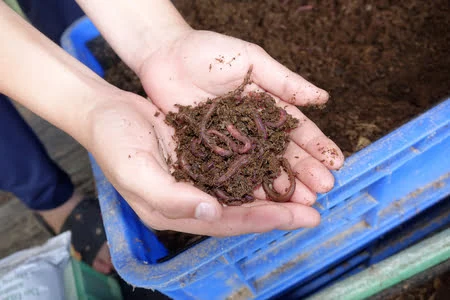
If using this method, place the worms in a container that is not clear and that light cannot pass through.
The light can confuse the worms and decrease their longevity. Once a week, sprinkle a spoonful of coffee grounds on the top of the soil to feed them.
For those that want to keep worms for longer periods of time, you will need to create a more permanent home like a worm box.
This is a larger container that can not only hold more worms but provide them with a suitable environment to live and reproduce.
You May Also Like: Senko Worms: The Definitive Guide To Senko Fishing (W/Pics!)
If you haven’t guessed yet, I love fishing and everything about it!
To learn more about why I started Panfish Nation, visit the About page and follow along on Social Media:


Download a copy of my FREE Lure Color Selection Chart & Knot Guide!
Stay up to date with fishing reports, tackle reviews, industry news, and much more! We respect your privacy, unsubscribe at any time.
